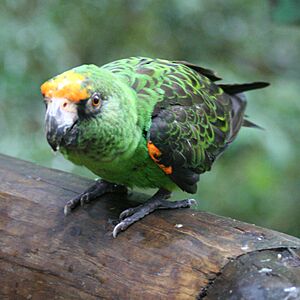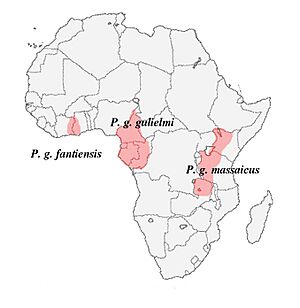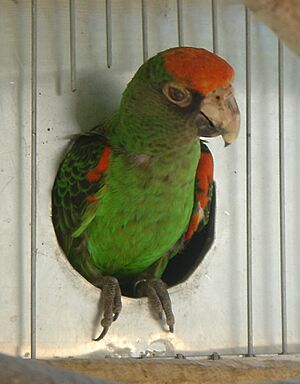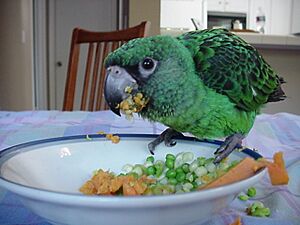Red-fronted parrot facts for kids
Quick facts for kids Red-fronted parrot |
|
|---|---|
 |
|
| P. g. fantiensis at Birds of Eden, South Africa | |
| Conservation status | |
| Scientific classification | |
| Genus: |
Poicephalus
|
| Species: |
gulielmi
|
| Subspecies | |
|
P. g. gulielmi, (Jardine 1849) |
|
 |
|
| Approximate ranges of subspecies | |
The red-fronted parrot (Poicephalus gulielmi), also known as Jardine's parrot, is a medium-sized green parrot. You can find these birds across many parts of Africa. They are known for the red or orange patches on their heads, legs, and wings. The exact color and size of these patches depend on which type of red-fronted parrot it is.
These parrots are quite popular as pets. People like them because they can learn to copy human speech and other sounds. To protect them, there are rules against catching wild parrots for the pet trade. This is managed by an agreement called CITES, which helps keep wild parrot populations safe.
Contents
What Does a Red-Fronted Parrot Look Like?
The red-fronted parrot is about 28 centimeters (11 inches) long. Most of its body is green. It has a short, black, square-shaped tail. The feathers on its head, neck, back, and wings are black with lighter green edges. This makes them look like they have a cool, wavy pattern.
Their lower beak is dark grey, and the upper beak is dark grey at the tip with a lighter, horn-colored base. Their eyes have red-orange irises (the colored part of the eye). The skin around their eyes is pinkish-grey, and their legs are grey-brown.
Young parrots, called juveniles, do not have the red or orange patches yet. They look darker with a paler beak and brown eyes. As they grow older, the colorful patches appear. Male and female red-fronted parrots look exactly the same on the outside.
Where Did the Name Come From?
The first red-fronted parrot to be studied by scientists was named Congo Jack. This parrot was brought to the United Kingdom from the Congo by the son of Sir William Jardine. Sir William Jardine was a famous naturalist.
Congo Jack became very friendly and would whistle and scream. Sir William Jardine named the species Pionus Gulielmi in honor of his son, William. The word "Gulielmi" means "William's" in Latin. This name was given in 1849.
Today, scientists recognize three main types, or subspecies, of the red-fronted parrot:
- Poicephalus gulielmi (Jardine 1849)
- P. g. gulielmi (Jardine 1849): This type has orange-red on its forehead, wings, and thighs. It lives in the Congo River basin. Some of these parrots have also been brought to the island of Puerto Rico.
- P. g. fantiensis (Neumann 1908): This type is a bit smaller. It has orange on its forehead and orange-red or orange on its wings. You can find it from Liberia to southern Ghana.
- P. g. massaicus (Fischer & Reichenow 1884): This type is like P. gulielmi but has less orange-red on its head. It lives in the highlands (high mountains) of southern Kenya and northern Tanzania.
Red-Fronted Parrot Behavior
Reproduction and Life Cycle
Red-fronted parrots build their nests inside holes in trees. A female parrot usually lays three or four white eggs. She sits on the eggs for about 27 days to keep them warm until they hatch. After the chicks hatch, they stay in the nest for about 80 days before they are ready to fly out on their own.
Feeding Habits
These parrots fly very fast above the forest. They often make loud calls as they travel between their sleeping spots and where they find food. They usually feed quietly high up in the trees. Their green feathers help them blend in perfectly with the leaves, making them hard to spot!
Red-Fronted Parrots as Pets
Red-fronted parrots are often called Jardine's parrots when they are kept as pets. They are becoming more and more popular because they are playful, smart, and loving. Some can even speak very clearly and are great at copying other bird sounds.
Their size, friendly nature, and voice make them good pets for people who live in apartments. They can sometimes make a loud, sharp call, but generally, they are not as noisy as some other parrots. Parrots raised by humans often bond well with their families. They might like one person a little more, but they are usually friendly with everyone.
These parrots are not as "needy" as some other pet birds. This means they can be left alone for longer periods without getting stressed. This is helpful for owners who work or have other activities.
Conservation Status
It is hard to know exactly how many wild red-fronted parrots live in Africa. This is because they live across such a huge area. One of the biggest dangers to them is people catching wild parrots to sell as pets.
To protect them, red-fronted parrots are listed under Appendix II of The Convention on the International Trade in Endangered Species (CITES). This means it is against the law to trade, import, or export any wild-caught red-fronted parrots. This rule helps keep their populations safe in the wild.





